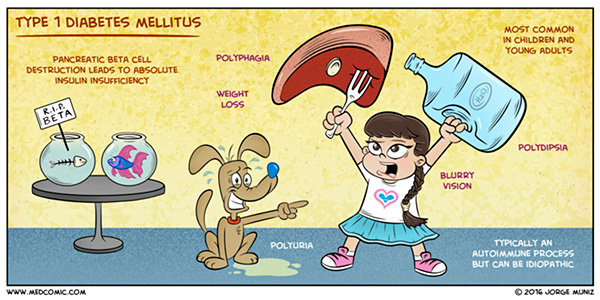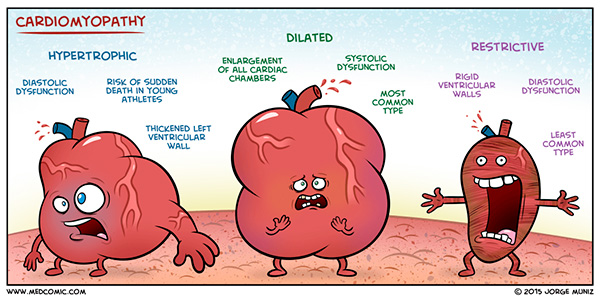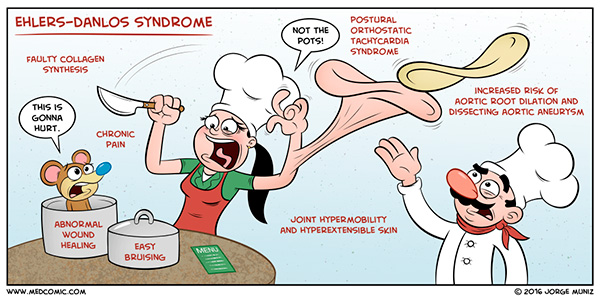March 16th, 2016
Drawing Meds: An Interview with Clinician-Artist Jorge Muniz, PA-C
Harrison Reed, PA-C
There’s nothing textbook about Jorge Muniz’s style. The physician assistant and emerging artist is as unique as his creation, Medcomic, a humorous cartoon collection that delivers medical education in a flurry of colorful punches.
Muniz juggles full-time clinical practice with the skyrocketing popularity of Medcomic, but the balancing act is nothing new. After all, he started the comic series while attending PA school at Nova Southeastern University in Orlando, FL. But what started as a study diversion for his friends soon gained attention from university faculty and, eventually, students and educators around the world.
The cartoons themselves bear all the evidence of their creator’s DNA. Muniz grew up on a diet of Looney Toons and 1990’s Nickelodeon cartoons. And while his style reflects those animated roots, his work carries the undeniable compassion of his medical profession.
Muniz has parlayed the success of his Medcomic website into a book of the same name. The print project, financed by donations through a Kickstarter campaign, was released last year and has found its way to bookshelves as far away as Australia.
The talented clinician-artist spoke with me about the emotions of cartoons, connecting with fans, and how he — quite literally — puts his profession front and center.
HR: What cartoons did you grow up watching?
JM: When I was really little, I watched a lot of Looney Toons… I studied that. And in the ‘90s, when I was probably in middle school, I watched Ren and Stimpy (on Nickelodeon). And that’s probably one of my favorite art styles because they are very emotive. The material is kind of gross and stupid, but when you look at the art it’s really cool. The Looney Toons and the ‘90s Nickelodeon, Rocko’s Modern Life — things like that, I liked.
But those old Looney Toons, they don’t really make cartoons like that anymore…It’s gotten away from the cartoon acting, using the cartoon as a puppet to express your ideas. So if you look at my artwork, I think I try to incorporate motion into the drawing even though it’s a still picture.
HR: Your cartoons are incredibly expressive and they have a ton of personality for things that are essentially inanimate objects. Do you ever base your cartoons on real people?
JM: Recently I drew a Type I diabetes cartoon and posted it (on Medcomic.com). It’s based off (my niece); she’s a young girl growing up with diabetes. So I drew that and dedicated it to her. And my whole family was really happy about seeing her depicted in a drawing.
The thing about drawing people in these cartoons is that there is a fine line between showing the disease process –and making it fun and fun to look at and humorous—and possibly going over the line and being offensive or making fun of the disease or the person that may have the disease. So I always try to keep that in mind and make it tasteful. But at the same time there’s ways to make it interesting and funny without poking fun. So it’s a balance and I think I walk that line pretty well for the most part.
HR: Did you ever think your artwork would turn into something that was successful in its own right?
JM: I’ve always wanted to achieve some success with my artwork because I’m so passionate about it. I never thought I would do a book. I was like, ‘I enjoy doing this and it’s helping people so I am going to keep posting this online.’ …And I was pretty consistent for the past two and a half, three years posting artwork. I think if you’re consistent with anything that you are passionate about, eventually you can achieve some success with it.
HR: You crossed a threshold with the Medcomic book, a project that was financed by a Kickstarter fund. You didn’t have any corporate overlords looking over your shoulder. How did that change the process of making a book?
JM: That was really important for me to maintain some creative freedom with the book. I did a lot of research before doing the Kickstarter, and I was concerned about that control, maybe a company taking the intellectual property of the drawings and then using it for other things. I guess I’m a little protective of the artwork and I wanted it to be for this purpose of, you know, helping students. So (self publication) let me maintain some control.
And it was a little nerve-wracking because I wasn’t sure if people would necessarily support that goal of making a book. I know people really liked seeing it online but a book is the next step. So, luckily it was successful and I got to make the book and I am really happy about that.
HR: A thousand years from now, future archeologists digging in central Florida only find one drawing. Which drawing do you want them to find?
JM: Oh man, that’s a tough one. You know, I think… I like… Hmm let me see…. Man that’s a hard question…. I like the cardiomyopathy one, I think.
HR: The drawings are kind of like your children. You have a really hard time picking between them. I can see the struggle on your face.
JM: (laughs) Yeah, hopefully they just dig up the book.
HR: What should our readers know about you and your work?
JM: One thing about the artwork is that I want to cover topics that people want to see. So I have a button up on the website for people to send requests. People may see the link and see the “Type Your Requests” and think that I don’t read it but I actually read every single email that comes through. And I appreciate everyone’s support. I get a lot of emails saying they really enjoy it, it helps. And I want to thank everyone and I do read the emails and take the suggestions into account — you know, what topics should be covered and things like that.
HR: So you’re a pretty accessible artist.
JM: I like interacting with people and hearing everyone’s thoughts.
HR: Do your patients know that you publish cartoons?
JM: Uh, no. But I think it might be cool to create some patient education materials with some artwork. One end that I haven’t really touched on is patient education… Maybe creating some pamphlets, or whatever the case may be, to get them to understand their conditions… Maybe it can help to create some materials that are more engaging.
Actually, there was someone who emailed me and they had Ehlers-Danlos syndrome. And she wanted to say “Hey, I want to request this drawing, Ehlers-Danlos syndrome, but I want to make sure that you include that this condition is very painful. We all live with this chronic pain, it’s very debilitating. And I feel like everyone thinks that it’s a stretchy-skin-disease but they forget this really affects our lives every day and it’s very painful. So that’s my request.” And I was like “OK, no problem.”
And I eventually did draw that cartoon and it’s up (on the website). And I wanted to get across that there was chronic pain in the drawing and I incorporated that. And then I got an email later and she was like “I love it!”
HR: There’s something very direct about the connection there. Emotion is kind of a central point in your drawings.
JM: Very emotional. Comic strips traditionally have to have a word bubble to express the idea. But a lot of the times (my work) is just the picture depicting the idea without any word bubbles. I try to make the image stand on its own. So you look at it, you get the picture.
I feel like it’s also cool because the PA profession seems to have this issue with being known in the media. In TV or movies, I feel like PAs are left out. If you create something that’s very accessible to a wide group, whether it be nurses, medical students, PA students, EMTs — and you have an international medical audience too — it kind of helps spread the PA profession in a positive way, too. I’m trying to make the PA profession a little more known. That’s why I put the “PA-C” on the front cover of my book. Some PAs might not have put the credential. I’m proud of the profession, so I want to put it out there.
Jorge Muniz currently lives and works in Kissimmee, FL. His work can be found at medcomic.com





You are the best, and we are very proud of you.
you’re a legend Jorge – we’ve even noticed your work down here in New Zealand! Thank you Harrison for writing this interview. I’ll be using it with my third year medical students next semester in a visual medicine course. Yeeharrr!! keep rocking on!
It’s my pleasure and privilege to write about special talent in the world of medicine. Thanks for reading!